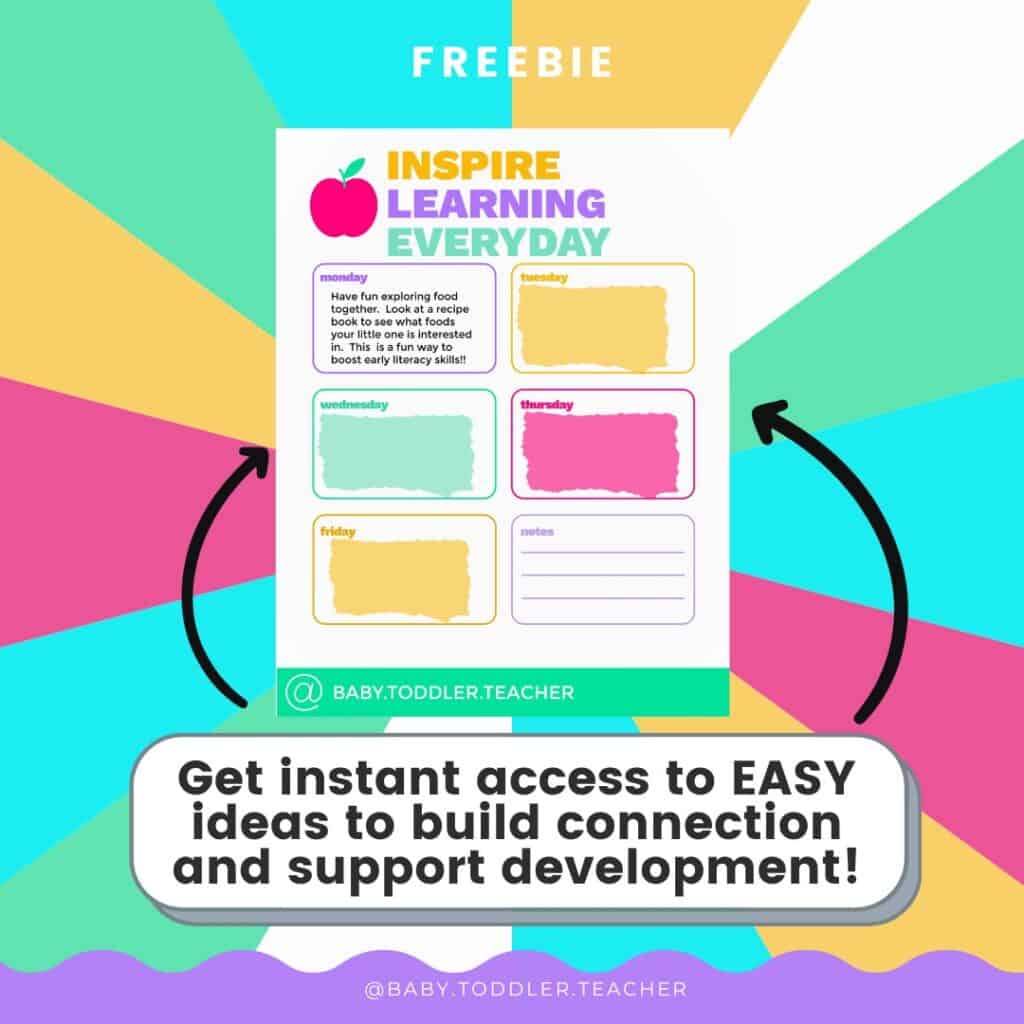As new parents to a 2-month-old baby, you are embarking on an exciting time of nurturing their growth and development.
I remember when each of my children were at this stage I had to navigate between engaging with them but also making sure not to overstimulate them.
This is a phase where your little one starts to become more aware of their surroundings and shows interest in the world around them.
It’s a perfect time to engage them in activities that not only promote their developmental milestones but also deepen your bond with them.
As a mom of 2 and a developmental therapist who specializes in babies and toddlers, I know that one of the best things you can do is find EASY ways to connect with your baby that won’t overwhelm you.
In this article, we will explore a series of simple and fun learning activities designed specifically for 2-month-old babies, helping you stimulate their senses, enhance their motor skills, and build a strong parent-child connection.
The activities we outline in this guide are designed with simplicity in mind, ensuring you can easily integrate them into your everyday routines.
Whether during play time, feeding, or diaper changes, these activities can seamlessly fit into your schedule without requiring any special preparation or resources.
By incorporating these learning activities into routine moments, you can turn otherwise mundane tasks into fun, enriching experiences for your newborn baby.
It’s all about making the most of those little moments throughout the day to stimulate your baby’s senses and promote their development, all while strengthening your bond with them.
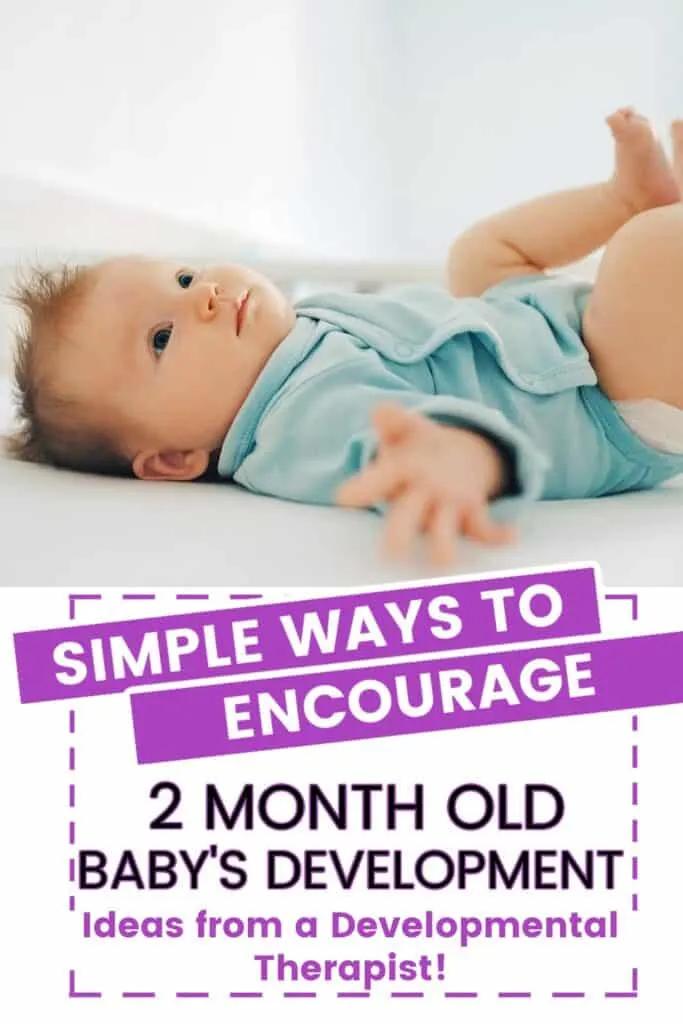
(This post may contain affiliate links. To read our full disclosure policy click here.)
What 2-month-old baby milestones can you expect?
At two months, babies start to hit several developmental milestones that signify their growth and cognitive advancement.
These milestones are individual and all babies develop at their own pace, but they generally encompass several areas.
If you ever have questions or concerns about your baby’s development be sure to reach out to early intervention or your pediatrician.
Knowing about the skills your baby is working on can help you know how to support your little one throughout the day.
Motor Milestones
At around two months old, your baby is beginning to develop stronger neck muscles and might be able to briefly hold their head up when lying on their stomach.
You might also notice that they begin to make smoother movements with their arms and legs and even start to close their hand around a toy or your finger.
Language Milestones
In terms of language development, your baby at this age may start cooing and making gurgling sounds.
They would start to recognize the sound of your voice and may even calm down at the sound. This is the beginning of their communication journey.
Cognitive Milestones
Cognitively, your baby is becoming more alert and starts to pay attention to faces, especially those of parents and close caregivers.
They begin to follow objects with their eyes and react to bright colors and bold patterns.
This is an initial step in their cognitive development where they are starting to understand their surroundings.
Social and Emotional Milestones
On the social-emotional front, your two-month-old baby will start to recognize familiar faces and may even flash a smile.
This is a significant social milestone as it’s the beginning of their social interaction.
This is also the start of a beautiful bonding phase where they start to develop a close attachment to parents and primary caregivers.
How to Encourage Emotional Development in a Two-Month-Old Baby
At this crucial stage of development, you can also enhance your baby’s social skills through simple and daily interactions.
One effective way is by talking to your baby about your emotions and labeling theirs.
For instance, when your baby is calm and content, you can say, “You look happy and peaceful!”
Similarly, if they are fussy, you could reflect, “You seem upset and it’s okay to have those feelings.”
This simple activity not only validates their emotions but also introduces them to the vocabulary of feelings.
Moreover, regular eye contact, smiling, and responding to their sounds and gestures can significantly encourage social development.
This helps create an environment where the baby feels understood and secure.
Remember, your young baby is absorbing more than you might realize during these early interactions, so be consistent and patient.
Incorporating these simple practices into your daily routine can create a strong emotional foundation for your baby.
Tummy Time is Great for Gross Motor Skills
Tummy time plays a critical role in a 2-month-old baby’s physical development.
It’s an activity that primarily strengthens the baby’s neck muscles, shoulders, core, and upper body muscles.
When a baby is placed on their belly, they instinctively attempt to lift their head to get a view of the world around them.
This action exerts their little muscles, gradually building strength and control.
The best thing about tummy time is that over time, this strength will be instrumental in achieving key developmental milestones like rolling over, sitting up, crawling, standing, and someday walking.
Aside from the physical benefits, tummy time also provides a new perspective for your baby, stimulating their senses and encouraging curiosity about their surroundings.
Therefore, incorporating regular tummy time into your baby’s daily routine is on stage of their growth.
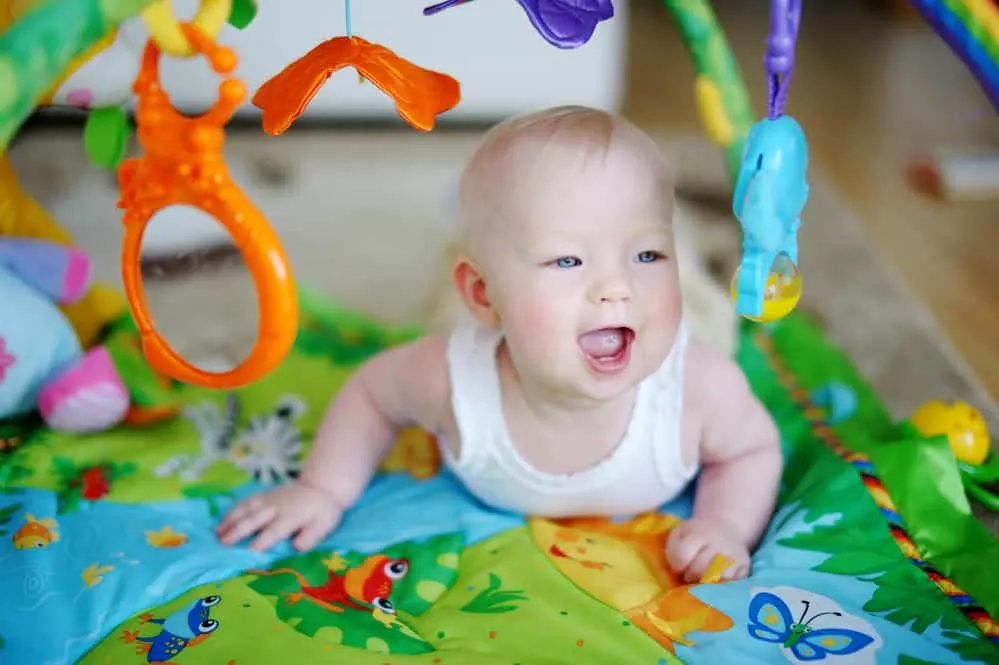
Using a Play Mat or Play Gym for Tummy Time
A play mat or play gym can be an excellent tool for enhancing your baby’s tummy time experience.
These accessories are usually padded, providing adequate support and comfort for your baby’s tiny body as they lie on their belly.
Moreover, play mats or gyms often come with a variety of built-in toys and features designed to stimulate your baby’s senses (this is the one my kids had.)
Colorful hanging toys, mirrors, and textured surfaces can attract your baby’s attention, encouraging them to lift their head and reach out to explore, thereby exercising their neck, shoulder, and upper body muscles.
Always remember to stay close and supervise your baby during tummy time to ensure their safety.
It is important to follow baby’s lead and start with short frequent tummy time sessions and give them breaks when needed.
One thing that works well is to get down on the floor with them and either show them toys, read a book, or just chat!
You do not want to make tummy time a negative experience.
When you place baby on a play mat or play gym, tummy time becomes a fun and productive activity that contributes significantly to your baby’s growth and development.
Sensory play is an effective way to stimulate a baby’s development, and can also encourage fine motor skills and hand-eye coordination when we are exploring touch.
These activities typically involve soft toys or objects that engage the baby’s senses, such as touch, sight, and hearing.
For example, a laundry basket filled with different textures can be a fun thing to explore as you give them the opportunity to feel different fabrics.
Sensory play does not mean you have set up anything fancy as everything is new to your baby.
Remember, the key to sensory play is to let your baby lead the exploration at their own pace.
It’s their curiosity and interest that will drive their learning and development.
But of course, always supervise these activities to ensure safety.
Explore Different Sounds with Your New Baby
Exploring different sounds with your baby is a great activity that contributes to sensory, language, and cognitive development.
Exposing your child to a variety of sounds, from the gentle lullaby you sing, tuning into some classical music, the rustling of leaves in the fresh air, the sound of birds chirping, stimulates their auditory senses.
They begin to discern differences in pitch, volume, and rhythm, which is essential for language acquisition.
As they imitate these sounds, they develop vocal control, paving the way for their first words.
Meanwhile, each new sound presents a puzzle for their brain to solve, fostering cognitive abilities.
They learn to associate sounds with objects or actions, enhancing their understanding of cause and effect.
Hence, the simple act of exploring sounds becomes a multifaceted educational experience.

Encourage Language Development During Diaper Changes
Diaper changes, despite being a routine and mundane task, can be turned into an enriching activity that promotes your baby’s language development.
Singing their favorite songs or nursery rhymes during this time can be an effective approach.
As you smoothly change their diapers, start singing familiar tunes.
The rhythm and melody of these songs captivate your baby, stimulating their auditory senses.
Not only does this create a pleasant distraction, but it also fosters language acquisition.
Songs and rhymes are filled with repetitive and rhyming words that aid in vocabulary building and phonetic awareness, gradually paving the way for their speech development.
Moreover, the one-on-one interaction creates a bond and gives your baby a sense of security.
So, the next time you’re ready for a diaper change, fill the air with music, and turn it into a fun, learning experience for your little one.
CLICK HERE if you want more EASY learning ideas to incorporate throughout the day!
Simple Activities to Encourage Visual Tracking
Encouraging your baby’s visual development is an integral part of their growth.
One effective way to do this is by using interesting objects or toys (you can see some of my favorites here) for them to track both vertically and horizontally.
Bright colors are attractive to an infant’s developing eyes and can hold their attention longer.
Hold a vibrant small toy or object above your baby’s sightline and then slowly move it up and down (vertical tracking) or from one side to another (horizontal tracking).
Have fun trying this out with different things to see how your baby responds.
Black, white and red objects can work well for this too.
It’s a simple, yet fun activity for developing your baby’s eyesight.
As with other activities, always ensure your baby is comfortable and engaged for a positive learning experience.

Grab your FREE Milestone Guide HERE.
Encouraging Independent Play from the Start
Independent play is a crucial element in a child’s development, fostering creativity, self-confidence, and problem-solving skills.
From the early stages, it’s beneficial to carve out time for your baby to play independently, under your careful supervision.
This doesn’t mean you should detach completely — instead, consider adopting the role of an observer.
While your baby is exploring toys, textures, or sounds on their own, be present and alert, but avoid guiding their play.
This approach allows your baby to navigate their own play and learning experiences, and it also provides opportunities for you to gain insights into their interests, strengths, and developmental progress.
Remember, the aim is to allow your child to engage with their environment naturally.
It’s through this unguided exploration that your baby begins to understand their world, fostering cognitive and physical development.
Always ensure their play area is safe and suitable for their age to ensure their well-being during these independent play sessions.
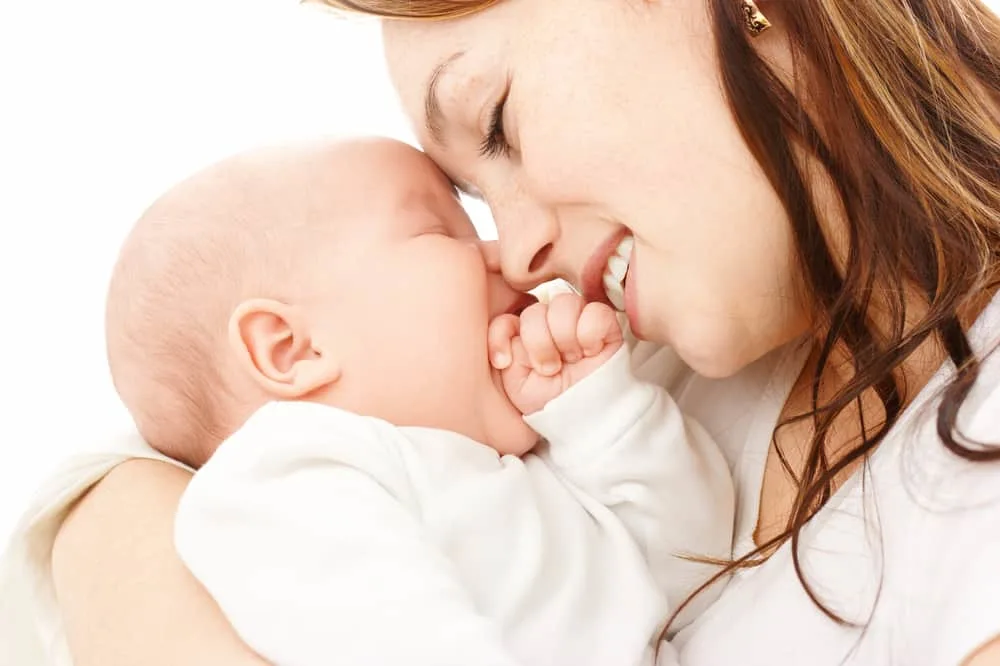
Enjoy Your New Baby!
In conclusion, these early months are a crucial time for your baby’s development, and incorporating these simple yet effective activities can be a great way to connect and encourage new skills.
From tummy time to sensory play, language development during diaper changes, and visual tracking activities, each of these 2-month-old baby activities can contribute to enhancing your baby’s physical, cognitive, and emotional development.
Remember, the key is to follow your baby’s lead, keep the experiences positive, and be patient and consistent.
Your baby is learning and absorbing more than you might realize, and these activities are setting the stage for their future learning and development.
Looking for other new parents?
Check out my community of over 100K caregivers over on Facebook!
Frequently Asked Questions
At this stage, you should be encouraging emotional development through interactions with your baby throughout the day. You can do this by connecting with your baby through conversations and comforting them when upset. You can also explore different sounds with them, engage in visual tracking exercises, and turn diaper changes into an enjoyable experience by singing nursery rhymes. All of these activities will help your baby reach important milestones while fostering their learning and development.
One of the best games that you can play with your baby is peek-a-boo. Peek-a-boo is an age-old classic that helps to develop your baby’s motor, communication, and problem solving skills. You can also use simple objects like brightly colored rattles or soft toys for sensory exploration and practice tracking by moving the object from side to side.
When it comes to tummy time start with really short frequent sessions throughout the day and work your way up to longer sessions—connecting tummy time to daily routines such as doing it right after a diaper change with help you to be consistent.
Related Posts You Will Enjoy
Top Balls of 2023 for Active Babies and Toddlers
The Best 3 Month Old Activities for Babies
When do babies start saying mama?
Easy Math Activities for Infants and Toddlers
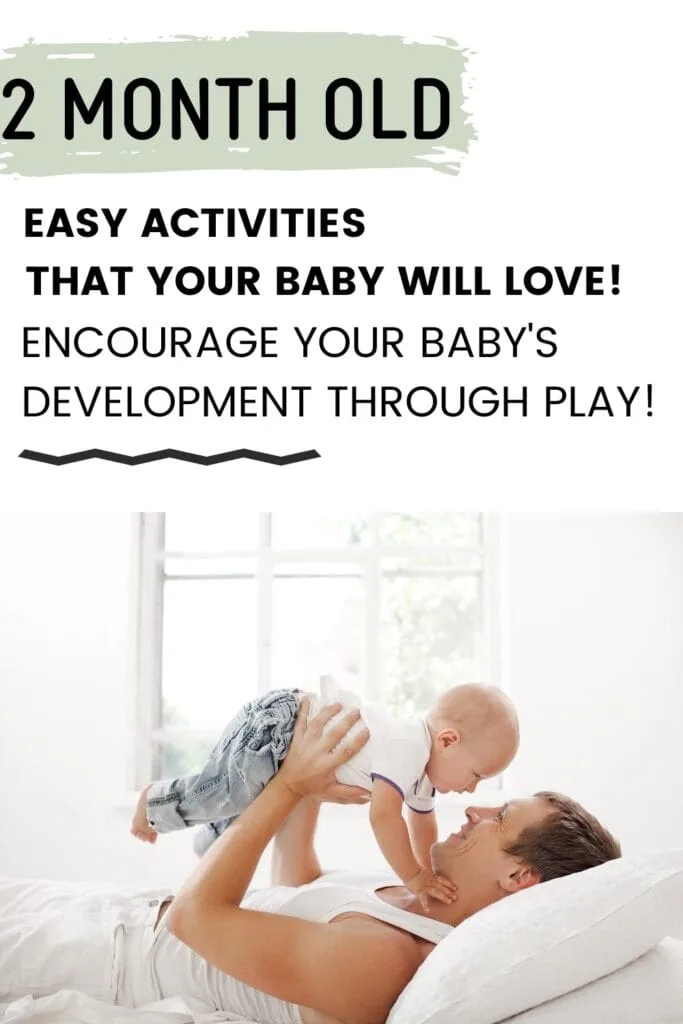

Kayla O’Neill has a master’s degree in education as well as a bachelor’s degree in special education with an emphasis in early childhood education. She has been working as a developmental therapist with babies and toddlers in early intervention since 2012. She is also a mom with two young children.
